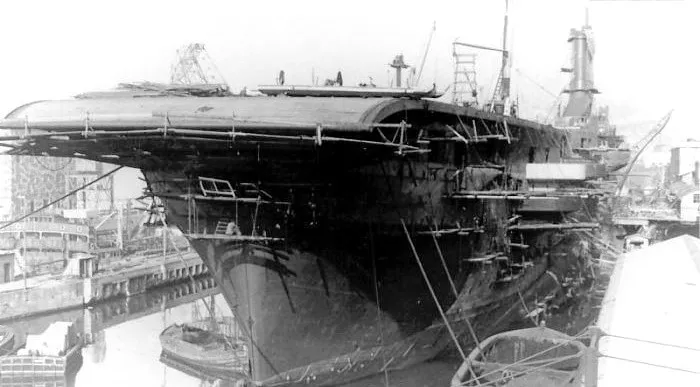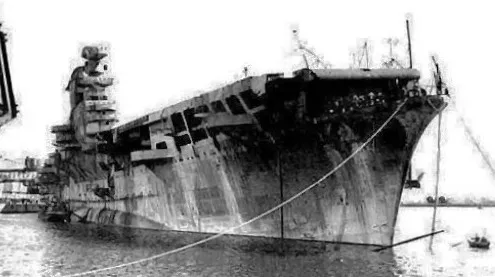Warships of Italy: Regia Marina Aircraft Carrier Aquila
Regia Marina Aircraft Carrier Aquila

(USN Photo)
Italian aircraft carrier Aquila at anchor at La Spezia in June 1951. Aquila was Italy's first proper aircraft carrier project; it was however not built from the keel up as such, and was never completed. After conducting comparative flight trials, the Italians eventually settled on the Re.2001 as their standard carrier fighter/fighter-bomber.

(Regia Marina Photo)
Italian aircraft carrier Aquila being converted from the ocean liner Roma, 1943.
Aquila (Eagle) was an Italian aircraft carrier converted from the transatlantic passenger liner SS Roma. During the Second World War, work on Aquila began in late 1941 at the Ansaldo shipyard in Genoa and continued for the next two years. With the signing of the Italian armistice on 8 September 1943, however, all work was halted and the vessel remained unfinished. She was captured by the National Republican Navy of the Italian Social Republic and the German occupation forces in 1943, but in 1945 she was partially sunk by a commando attack of Mariassalto, an Italian royalist assault unit of the Co-Belligerent Navy of the Kingdom of Italy, made up by members of the former Decima Flottiglia MAS. Aquila was eventually refloated and scrapped in 1952.
Aquila was nearing 90% completion and had passed her first static test when Italy surrendered to the Allies on 8 September 1943. Germany and its puppet state, the Italian Social Republic, then seized the ship and placed it under guard. However, because of the general poor military situation and the ongoing bombing attacks on her and the nearby naval infrastructure, work never resumed. Aquila was later damaged again on 16 June 1944, during an Allied air attack on Genoa. By that same year, the Germans had already started to loot the ship and partially dismantle her.Near the end of the war, the royalist Italian Co-belligerent Navy feared the Germans might use Aquila as a blockship to the entrance to Genoa harbor, just as they did with her sister ship, the converted aircraft carrier Sparviero (formerly the ocean liner Augustus) a few months prior. Mariassalto divers from the former Decima Flottiglia MAS then executed a daring sabotage operation on the night of the 18 and 19 April 1945, in which they partially sunk Aquila in a harmless location. Raised after the war, Aquila was towed to La Spezia in 1949 and renamed Pontone P227. Consideration was given to possibly completing her or converting her to other civilian uses, but this was deemed either too expensive or too politically problematic. She was eventually scrapped in 1952. (Wikipedia)
Aquila′s planned air complement was 51 non-folding Reggiane Re.2001 OR fighter-bombers: 41 stowed in the hangar deck (including 15 suspended from the deck head) and 10 on the flight deck in a permanent deck park. A folding-wing version of the Re.2001 was planned, which would have increased the size of Aquila′s air group to 66 aircraft, but this never materialized. Only 10 Re.2001s were fully converted for carrier use. They were given tail hooks, RTG naval radio equipment and bomb racks for carrying 650 kg (1,430 lb) of bombs. They were also armed with two 12.7 mm (0.5 in) Breda-SAFAT machine guns mounted above the engine cowling. At least one Re.2001G was under test at Perugia as a naval torpedo bomber and was given a lengthened tail wheel strut to accommodate the added height of a torpedo suspended below the fuselage. (Wikipedia)

(Regia Marina Photo)
The transatlantic liner Roma was temporarily renamed Falco and later Aquila, during the transformation work to turn it into an aircraft carrier.

(Regia Marina Photo)
Italian aircraft carrier Aquila in the port of Genoa damaged following an Allied bombing, 1944.
Italian aircraft carrier Sparviero
Sparviero (Sparrowhawk) was an Italian aircraft carrier designed and built during the Second World War for the Regia Marina. She was originally the ocean liner MS Augustus built in 1926 for Navigazione Generale Italiana, but was transferred to the new Italian Line after the merger of Navigazione Generale Italiana with the Lloyd Sabaudo and the Cosulich Line. The conversion was started in 1942 originally under the name Falco but was never completed, and the ship was never delivered to the Regia Marina (Royal Italian Navy). She began to be scrapped in 1947, a process completed by 1951. (Wikipedia)

